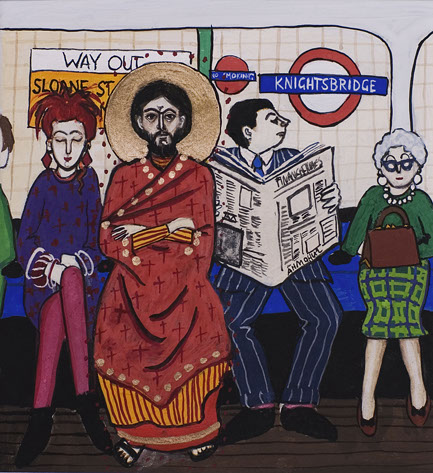 re events that are apparently causally unrelated occurring together in a meaningful manner. To count as synchronicity, the events should be unlikely to occur together by chance. The concept of synchronicity was first described by Swiss psychologist Carl Gustav Jung in the 1920s.
re events that are apparently causally unrelated occurring together in a meaningful manner. To count as synchronicity, the events should be unlikely to occur together by chance. The concept of synchronicity was first described by Swiss psychologist Carl Gustav Jung in the 1920s.
The concept does not question, or compete with, the notion of causality. Instead, it maintains that just as events may be grouped by cause, they may also be grouped by their meaning. Since meaning is a complex mental construction, subject to conscious and subconscious influence, not every correlation in the grouping of events by meaning needs to have an explanation in terms of cause and effect."
In 1983, the Police issued their fifth album - Synchronicity - the same year that Arthur Koestler and his wife took their own lives before succumbing to the effects of leukemia. Sting had been reading Koestler's The Roots of Coincidence and was turned on to Carl Jung's ideas and insights and found himself drawn into an every more sophisticated blending of poetry with pop and world music influences.
I've been thinking of both the idea and the album of late as I've been riffing on the notion of "practicing resurrection." In St. Paul's words (or more likely one writing in the apostle's name and style) Ephesians 4 urges us to "grow up and mature into adults not tossed about like children." Clearly, Paul himself was of this mind when he spoke of "putting childish things behind" in I Corinthians 13. And also in Romans 12 where we are called into live as "a living sacrifice... by the renewal of our minds."
And so it fascinates me when I start to notice similar themes from other writers and artists working the same vein but in very different contexts. Yesterday, for example, Fr. Richard Rohr posted this in his series on being an adult person of faith.
Adult spirituality begins when you start learning to live with ambiguity, rather than insisting on absolute certitud
 e every step of the way. Why do you think we call it “faith”? Up to that point it’s just juridical law, black-and-white thinking, but not the restorative justice exemplified by Jesus. You can perfectly obey the law with no need for any real “discernment of spirits” (1 Corinthians 12:10), or any need for subtlety, love, forgiveness, or patience. You don’t even need to pray for guidance and growth, because you have all your answers already in place.
e every step of the way. Why do you think we call it “faith”? Up to that point it’s just juridical law, black-and-white thinking, but not the restorative justice exemplified by Jesus. You can perfectly obey the law with no need for any real “discernment of spirits” (1 Corinthians 12:10), or any need for subtlety, love, forgiveness, or patience. You don’t even need to pray for guidance and growth, because you have all your answers already in place.
Fr. Karl Rahner, SJ said that the mind’s deepest need is not for answers but for communion. I call this “living inside the unified field,” when you can live in union with God, with yourself, and in union with what is. Then you don’t need to perfectly understand everything, and surely not right now! You can live with more mystery, more insolvability, and surely much more peace. The dualistic mind, which is “all-or-nothing thinking,” is inherently and always un-peaceful and thrives on contention.
And then there was his posting from this morning:
St. Thomas Aquinas said in the thirteenth century: “If it is true, then it is from the Holy Spirit.” The important question is not who said it or
 where it was written, but “Is it true?” If there is indeed one God of all the earth, then it is this one God who is breaking through in every age and culture, and monotheists should be the first to recognize this one truth (Ephesians 4:4-6) and that God is “all in all” (1 Corinthians 15:28). As Rumi said, “There are a thousand ways to kneel and kiss the ground.”
where it was written, but “Is it true?” If there is indeed one God of all the earth, then it is this one God who is breaking through in every age and culture, and monotheists should be the first to recognize this one truth (Ephesians 4:4-6) and that God is “all in all” (1 Corinthians 15:28). As Rumi said, “There are a thousand ways to kneel and kiss the ground.”
+ Many writers in the early Christian era called the radical shift away from the judging and separate self “contemplation.”
+ Buddhists called it meditation, sitting, or practicing.
+ Hesychastic Orthodoxy called it prayer of the heart.
+ Sufi Islam called it ecstasy or delight in God.
+ Hasidic Judaism called it “living from the divine spark within.”
+ Vedantic Hinduism (the earliest) spoke of it as non-dual knowing or simply breathing.
+ Native religions found it in communion with nature itself and the Great Spirit through dance, ritual, and sexuality, and often enjoyed “original participation,” as Owen Barfield called it.
Presence is experienced in a fully participative way, outside and larger than anything the mind can do by itself.
Eugene Peterson puts it like this: Christian spirituality means living in the mature wholeness of the gospel. It means taking all the elements of your life - children, spouse, job, weather, possessions, relations - and experiencing them all as an act of faith. No wonder I keep thinking that the Police have yet another song made for a church curious about an adult faith...
credits:
1) Annette Banks @ www.thefigurativeartbeat.com/annett-e-banks-figuative-art-is-energy-in-motion/
2) Candle @ http://www.mamaguru.com/
3) Black Jesus @ http://www.abovetopsecret.com/




No comments:
Post a Comment